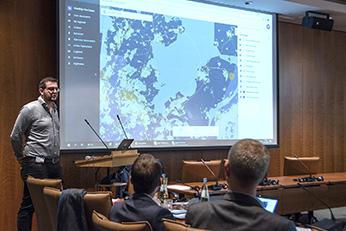The SESAR U-space PODIUM project workshop brought together engaged stakeholders on 17 October in Brussels to review the conclusions of the project. The project concluded that U-space services for the pre-flight phase are practically ready for deployment, but that more action is needed to ensure that U-space services can take-off in the flight execution phase.

PODIUM has performed U-space demonstrations for beyond visual line of sight (BVLOS) and VLOS flights at five operational sites in Europe, namely: Hans Christian Andersen airport, Odense; the Netherlands RPAS Test Centre, Marknesse; Groningen Airport Eelde; the Drones Paris Région cluster, Brétigny-sur-Orge; and Rodez-Aveyron airport.
During the morning session, NLR pilots from the Netherlands RPAS Test Centre, Matthijs van Essen and, Jasper van der Vorst, performed a live demonstration - using the Unifly UTM system – of the registration, flight planning and authorisation flows for a BVLOS flight at Groningen Airport Eelde. Since it wouldn’t be practical to fly a drone in the PILATUS meeting room, Nicolas Sonnet of Aeromapper used a video of a BVLOS flight at Brétigny to explain the practicalities of using the UTM system during the flight execution phase.
Jean-Phillipe Bonhomme of the Drones Paris Region cluster led the expert panel discussions in the afternoon. “I need to work with six authorities to get approval for a BVLOS flight in Denmark,” stresses Brad Beach of UAS Denmark. “The way that ATC handles drones is very unpredictable; there is a real lack of harmonisation in Europe”, adds Bastien Mancini of DELAIR. “I can’t use ‘see and avoid’ to spot a drone when I’m on duty in the tower – the Airbus solution really helps me to see the DELAIR drone on the screen,” explains Charles Dournel, an air traffic controller at Rodez-Aveyron airport. And there were many other valuable insights highlighted during the two panel sessions on operational and technical aspects, and business considerations.
“Thanks to PODIUM, innovative drone pilots and manufacturers, air traffic controllers and nominal U-space supervisors have used U-space services and systems hands-on,” explains Peter Alty, the EUROCONTROL project coordinator, “providing the team with valuable insights on the ease-of-use, the benefits, and areas for improvement.“
PODIUM concludes that there is a very strong demand from all stakeholders for U-space solutions that can ease the burden of obtaining flight authorisations, and that increase situational awareness to enable safety and efficiency benefits during flight execution. The project concludes that U-space services for the pre-flight phase are practically ready for deployment, but that significant action is needed to ensure that U-space services can really take-off in the flight execution phase. In particular, PODIUM has important recommendations relating to tracking, the human machine interface for drone pilots, and the access to trustworthy data. PODIUM aims to publish its final demonstration report in November 2019.
The full set of presentations from the event is available here. We also screened lots of videos during the event. Take a look at this NLR video which shows PODIUM in action at Groningen Airport Eelde in June.
Download the conclusions and recommendations
PODIUM stands for Proving Operations of Drones with Initial Unmanned aircraft system traffic Management. The main PODIUM partners are EUROCONTROL (project coordinator), Airbus, Delair, Drone Paris Region, DSNA, Integra Aerial Services, Naviair, NLR, Orange and Unifly. PODIUM supports U-space, the European vision for the safe, secure and efficient handling of drone traffic, and a key enabler for a growing drone market to generate economic and societal benefits.

